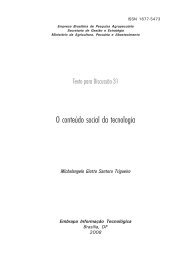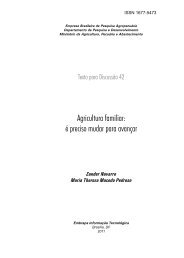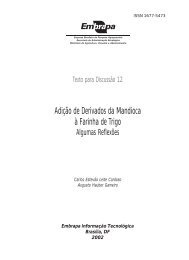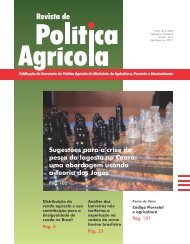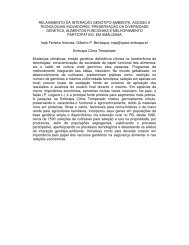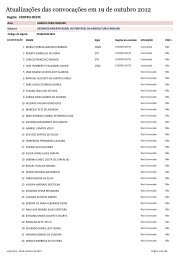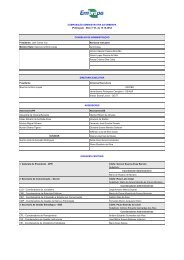Ministry of Agriculture, Livestock and Food Supply - Embrapa
Ministry of Agriculture, Livestock and Food Supply - Embrapa
Ministry of Agriculture, Livestock and Food Supply - Embrapa
Create successful ePaper yourself
Turn your PDF publications into a flip-book with our unique Google optimized e-Paper software.
matter). Thus, the final residue is more appropriate for use as organic fertilizer<br />
because the nitrogen is mineralized <strong>and</strong> some nutrients are partially solubilized<br />
(SCHERER et al., 1996).<br />
Agr<strong>of</strong>orestry residues<br />
A sizable proportion <strong>of</strong> the electric power produced from biomass in<br />
Brazil comes from agricultural, forestry <strong>and</strong> agro-industrial residues. According<br />
to the 2004 National Energy Balance, 2.86% <strong>of</strong> the electric power in the national<br />
energy matrix comes from biomass: 1.69% from sugarcane bagasse <strong>and</strong><br />
1.17% from wood <strong>and</strong> various agricultural <strong>and</strong> forestry residues.<br />
The maximum generation potential <strong>of</strong> the wood <strong>and</strong> rice sectors is much<br />
smaller <strong>and</strong> has been estimated at 594 MW for wood <strong>and</strong> 200 MW for rice, on<br />
average. If only 50% <strong>of</strong> this potential were used due to economic reasons or<br />
transportation difficulties, about 300 MW <strong>and</strong> 100 MW would be generated,<br />
respectively. After subtracting the installed capacity – 142 MW for wood residues<br />
<strong>and</strong> 9 MW for rice hulls – the remaining wood <strong>and</strong> rice biomass would produce<br />
approximately 160 MW <strong>and</strong> 90 MW, respectively, in the short term.<br />
Although the identified power generation potential in the wood <strong>and</strong> rice<br />
industries is rather unimportant in national terms, it is relevant from the regional<br />
st<strong>and</strong>point. The wood production <strong>and</strong> processing centers are located in the states<br />
<strong>of</strong> Pará, Mato Grosso <strong>and</strong> Rondônia (native wood) <strong>and</strong> Santa Catarina, Paraná<br />
<strong>and</strong> São Paulo (planted forests). In the former case, the future <strong>of</strong> the forestry<br />
activities is uncertain, so that it would be important to analyze what the actual<br />
prospects are in the context <strong>of</strong> the sustainable exploitation <strong>of</strong> forestry resources.<br />
As in all renewable sources <strong>of</strong> energy, in order to effectively exploit the<br />
electric power generation potential from residual sugarcane, wood <strong>and</strong> rice<br />
biomass it would be necessary to define <strong>and</strong> implement medium- <strong>and</strong> long-term<br />
development policies establishing clear conditions that effectively encourage<br />
businesses to use this economically viable <strong>and</strong> strategically significant potential.<br />
Forestry residues<br />
Forestry residues obtained through appropriate management <strong>of</strong> reforestation<br />
projects can increase the energy yield <strong>of</strong> forests. Here, again, few statistics are<br />
available due to factors associated with regional diversity, such as faunas,<br />
technologies, soils, <strong>and</strong> climates. Nevertheless, Woods <strong>and</strong> Hall (1994) estimated<br />
the energy potential <strong>of</strong> forestry residues in the world at 35 EJ/year (10GW). A<br />
99



